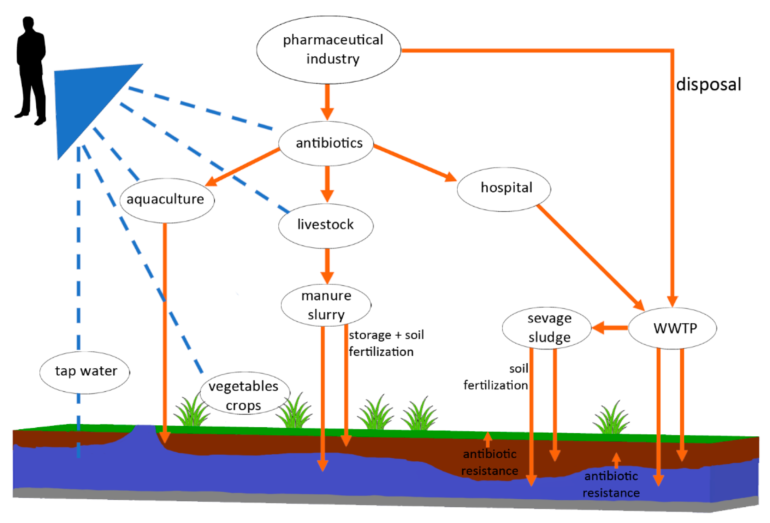Bacteria that render colistin, a “last resort” antibiotic, ineffective are lurking in SoCal’s wastewater. While bacteria resistant to colistin have been found elsewhere in the world, this marks the first detection in Los Angeles wastewater. The bacteria and associated genes that provide resistance to colistin were discovered at the county’s two largest wastewater plants. One treatment center serves 4 million residents, the other serves 3.5 million.
The resistant bacteria and associated genes were discovered by Adam Smith, a professor in the Sonny Astani Department of Civil and Environmental Engineering, and documented in a new paper published in Environmental Science & Technology Letters. Smith, who documented COVID’s presence in wastewater during the pandemic, admits this type of antibiotic resistant gene has been found elsewhere in the world (6 of 7 continents, he said) but this is first time there are traces of this particular antibiotic resistance in L.A.
Smith says that COVID made wastewater surveillance mainstream, and it created an opportunity to test for other illnesses. He and his team observed resistance in two opportunistic pathogens and “discovered two novel small plasmids harboring colistin resistance genes. These small plasmids are considered mobile genetic elements, meaning transmissible between different types of bacteria.” While the antibiotic resistant bacteria were found in two sites—one on the coast by LAX and another in the Carson area, he believes that these two water treatment sites are representative of L.A. County and the antibiotic resistance genes are likely circulating throughout the county.
What is particularly concerning, he notes, is that this antibiotic for which there is evidence of resistance, is only used in situations when all other options fail for conditions that can’t be treated with, or haven’t responded to antibiotics like penicillin.
His concern is that these resistance genes are what he calls “mobile.” They lend themselves to what he calls “horizontal transfer” of their antibiotic-resistance genes to other bacteria, meaning they can transfer to completely unrelated bacteria. Thus rendering these new bacteria antibiotic-resistant.
Smith refers to the colistin resistant bacteria as “opportunistic pathogens” that can impact individuals who are immunocompromised.
And says Smith, “if they become resistant…we’re potentially getting to a place where antibiotics are no longer usable to combat those infections then we have to come up with new antibiotics or other therapies that could.”
Why is this happening?
Smith speculates that the reason we are seeing the rise of antibiotic resistance is that during the pandemic, certain “antibiotic stewardship programs took a backseat.” He says during the pandemic there was an increased intake of antibiotics worldwide. However, prior to the pandemic there was more attention paid to programs that would dissuade physicians from over-prescribing of antibiotics. Over-prescription is a problem, says Smith, because the bacteria left behind when using antibiotics are antibiotic-resistant and with overuse he says, “we are propagating antibiotic-resistant bacteria.”
Smith believes beyond monitoring what happens at the doctor’s office and point-of-care, we also need to continuously monitor or “characterize” our wastewater and the surrounding microbial community. He believes we also must track how we use byproducts of our wastewater such as biosolids which provide nutrients for agricultural (but non-food production) purposes in crops like cotton. (Antibiotic-resistant t-shirt anyone?) He insists we need a “One Health” approach so that we are not just looking at human hosts, but animals and the environment and “any other reservoirs.”
Smith advocates not just for more frequent testing but for testing at more sites.
During COVID, he remarked that scientists were able to pinpoint infection at the community or even building level. This tracking allowed for targeted health interventions. He imagines that this could be quite relevant for a senior care facility, for example, that might be at higher risk of being exposed to antibiotic resistant bacteria.
Smith also reflects on how this discovery might move therapies forward based on the current state of antibiotics and healthcare. “Before we developed antibiotics such as penicillin in the forties, we actually treated bacterial infections with viruses that specifically infect bacteria, known as bacteriophages. We could revisit the idea of using these bacteria specific viruses to combat infections.”
If we don’t address the issue, Smith says, “antibiotic resistance could be the next pandemic.”
More information:
Phillip Wang et al, Emergence of Mobile Colistin Resistance Genes within Los Angeles County Wastewater, Environmental Science & Technology Letters (2023). DOI: 10.1021/acs.estlett.3c00080
Provided by
University of Southern California
Citation:
Bacteria resistant to ‘last resort’ antibiotic found in LA County wastewater (2023, April 6)



